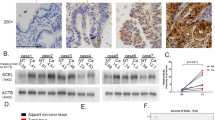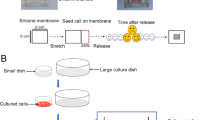Abstract
Fibrinogen plays an important role in tumor progression. Here, we explored the role of fibrinogen in gallbladder cancer (GBC) metastasis. The plasma fibrinogen level in M1 GBC patients was higher than in M0 GBC patients, indicating that fibrinogen may participate in GBC metastasis. Treatment of GBC cell lines with fibrinogen promoted metastasis and induced the expression of intercellular adhesion molecule 1 (ICAM1). ICAM1 overexpression promoted metastasis and knockdown inhibited it. The cell adhesion and transendothelial migration of GBC cells were enhanced by fibrinogen treatment and ICAM1 overexpression. In addition, the medium of fibrinogen-treated and overexpression-ICAM1 NOZ cells exhibited enhanced macrophages recruitment. This may work in concert to promote angiogenesis. Immunohistochemistry results on clinical specimens showed that higher fibrinogen levels, higher ICAM1 expression, higher blood vessel density, and higher macrophage levels were present simultaneously. Collectively, this study indicates fibrinogen promotes metastasis and extravasation by inducing ICAM1 expression to enhance tumor cell migration, cell adhesion, transendothelial migration and promote angiogenesis and increase vascular endothelial permeability.




Similar content being viewed by others

Data availability
The data that support the findings of this study are available from the corresponding author upon reasonable request.
References
Sung H, et al. Global Cancer Statistics 2020: GLOBOCAN estimates of incidence and mortality worldwide for 36 cancers in 185 countries. CA Cancer J Clin. 2021;71(3):209–49.
Li M, et al. Genomic ERBB2/ERBB3 mutations promote PD-L1-mediated immune escape in gallbladder cancer: a whole-exome sequencing analysis. Gut. 2019;68(6):1024–33.
Lindner P, Holmberg E, Hafstrom L. Gallbladder cancer: no improvement in survival over time in a Swedish population. Acta Oncol. 2018;57(11):1482–9.
Ren T, et al. Analysis of treatment modalities and prognosis of patients with gallbladder cancer in China from 2010 to 2017. Zhonghua Wai Ke Za Zhi. 2020;58(9):697–706.
Ren T, et al. Prognostic significance of regional lymphadenectomy in T1b gallbladder cancer: results from 24 hospitals in China. World J Gastrointest Surg. 2021;13(2):176–86.
Wu X, et al. Hepatopancreatoduodenectomy for advanced biliary malignancies. Chin Med J. 2022. https://doi.org/10.1097/cm9.0000000000002067.
Baiu I, Visser B. Gallbladder cancer. JAMA. 2018;320(12):1294.
Song X, et al. Overview of current targeted therapy in gallbladder cancer. Signal Transduct Target Ther. 2020;5(1):230.
Cui XY, et al. Modified FOLFIRINOX for unresectable locally advanced or metastatic gallbladder cancer, a comparison with GEMOX regimen. Hepatobiliary Surg Nutr. 2021;10(4):498–506.
Wu XS, et al. LncRNA-PAGBC acts as a microRNA sponge and promotes gallbladder tumorigenesis. EMBO Rep. 2017;18(10):1837–53.
Shu YJ, et al. SPOCK1 as a potential cancer prognostic marker promotes the proliferation and metastasis of gallbladder cancer cells by activating the PI3K/AKT pathway. Mol Cancer. 2015;14(1):12.
Li M, et al. Whole-exome and targeted gene sequencing of gallbladder carcinoma identifies recurrent mutations in the ErbB pathway. Nat Genet. 2014;46(8):872–6.
Redman CM, Xia H. Fibrinogen biosynthesis. Assembly, intracellular degradation, and association with lipid synthesis and secretion. Ann N Y Acad Sci. 2001;936:480–95.
Luyendyk JP, Schoenecker JG, Flick MJ. The multifaceted role of fibrinogen in tissue injury and inflammation. Blood. 2019;133(6):511–20.
Kattula S, Byrnes JR, Wolberg AS. Fibrinogen and fibrin in hemostasis and thrombosis. Arterioscler Thromb Vasc Biol. 2017;37(3):e13-21.
Vilar R, et al. Fibrin(ogen) in human disease: both friend and foe. Haematologica. 2020;105(2):284–96.
Perisanidis C, et al. Prognostic role of pretreatment plasma fibrinogen in patients with solid tumors: a systematic review and meta-analysis. Cancer Treat Rev. 2015;41(10):960–70.
Shu YJ, et al. Clinical and prognostic significance of preoperative plasma hyperfibrinogenemia in gallbladder cancer patients following surgical resection: a retrospective and in vitro study. BMC Cancer. 2014;14:566.
Lin Y, et al. Clinical significance of plasma D-dimer and fibrinogen in digestive cancer: a systematic review and meta-analysis. Eur J Surg Oncol. 2018;44(10):1494–503.
Simpson-Haidaris PJ, Rybarczyk B. Tumors and fibrinogen. The role of fibrinogen as an extracellular matrix protein. Ann N Y Acad Sci. 2001;936:406–25.
Zhang F, et al. Fibrinogen promotes malignant biological tumor behavior involving epithelial-mesenchymal transition via the p-AKT/p-mTOR pathway in esophageal squamous cell carcinoma. J Cancer Res Clin Oncol. 2017;143(12):2413–24.
Dzikowski L, et al. Fibrinogen in the glioblastoma microenvironment contributes to the invasiveness of brain tumor-initiating cells. Brain Pathol. 2021;31(5): e12947.
Palumbo JS, et al. Spontaneous hematogenous and lymphatic metastasis, but not primary tumor growth or angiogenesis, is diminished in fibrinogen-deficient mice. Cancer Res. 2002;62(23):6966–72.
Zheng S, et al. Platelets and fibrinogen facilitate each other in protecting tumor cells from natural killer cytotoxicity. Cancer Sci. 2009;100(5):859–65.
Adams GN, et al. Colon cancer growth and dissemination relies upon thrombin, stromal PAR-1, and fibrinogen. Cancer Res. 2015;75(19):4235–43.
Steinbrecher KA, et al. Colitis-associated cancer is dependent on the interplay between the hemostatic and inflammatory systems and supported by integrin α(M)β(2) engagement of fibrinogen. Cancer Res. 2010;70(7):2634–43.
Sharma BK, et al. Fibrinogen activates focal adhesion kinase (FAK) promoting colorectal adenocarcinoma growth. J Thromb Haemost. 2021;19(10):2480–94.
Zhang Y, et al. Single-cell RNA-sequencing atlas reveals an MDK-dependent immunosuppressive environment in ErbB pathway-mutated gallbladder cancer. J Hepatol. 2021;75(5):1128–41.
Mosesson MW. Fibrinogen and fibrin structure and functions. J Thromb Haemost. 2005;3(8):1894–904.
Bui TM, Wiesolek HL, Sumagin R. ICAM-1: a master regulator of cellular responses in inflammation, injury resolution, and tumorigenesis. J Leukoc Biol. 2020;108(3):787–99.
Tariq NU, McNamara MG, Valle JW. Biliary tract cancers: current knowledge, clinical candidates and future challenges. Cancer Manag Res. 2019;11:2623–42.
Ye YY, et al. MicroRNA-30a-5p inhibits gallbladder cancer cell proliferation, migration and metastasis by targeting E2F7. Cell Death Dis. 2018;9(3):410.
Shu YJ, et al. MicroRNA-29c-5p suppresses gallbladder carcinoma progression by directly targeting CPEB4 and inhibiting the MAPK pathway. Cell Death Differ. 2017;24(3):445–57.
Wang JW, et al. Identification of metastasis-associated proteins involved in gallbladder carcinoma metastasis by proteomic analysis and functional exploration of chloride intracellular channel 1. Cancer Lett. 2009;281(1):71–81.
Cui X, et al. Hacking macrophage-associated immunosuppression for regulating glioblastoma angiogenesis. Biomaterials. 2018;161:164–78.
Qian BZ, Pollard JW. Macrophage diversity enhances tumor progression and metastasis. Cell. 2010;141(1):39–51.
Tyagi N, et al. Fibrinogen induces endothelial cell permeability. Mol Cell Biochem. 2008;307(1–2):13–22.
Muradashvili N, et al. Fibrinogen-induced increased pial venular permeability in mice. J Cereb Blood Flow Metab. 2012;32(1):150–63.
Tomita T, Kato M, Hiratsuka S. Regulation of vascular permeability in cancer metastasis. Cancer Sci. 2021;112(8):2966–74.
Yang Y, et al. Bispecific CAR T Cells against EpCAM and Inducible ICAM-1 overcome antigen heterogeneity and generate superior antitumor responses. Cancer Immunol Res. 2021;9(10):1158–74.
Raghu H, Flick MJ. Targeting the coagulation factor fibrinogen for arthritis therapy. Curr Pharm Biotechnol. 2011;12(9):1497–506.
Sahni A, et al. Fibrinogen synthesized by cancer cells augments the proliferative effect of fibroblast growth factor-2 (FGF-2). J Thromb Haemost. 2008;6(1):176–83.
Roche Y, et al. Fibrinogen mediates bladder cancer cell migration in an ICAM-1-dependent pathway. Thromb Haemost. 2003;89(6):1089–97.
Huang C, et al. Tumour-derived Interleukin 35 promotes pancreatic ductal adenocarcinoma cell extravasation and metastasis by inducing ICAM1 expression. Nat Commun. 2017;8:14035.
Taftaf R, et al. ICAM1 initiates CTC cluster formation and trans-endothelial migration in lung metastasis of breast cancer. Nat Commun. 2021;12(1):4867.
Rybarczyk BJ, Simpson-Haidaris PJ. Fibrinogen assembly, secretion, and deposition into extracellular matrix by MCF-7 human breast carcinoma cells. Cancer Res. 2000;60(7):2033–9.
Acknowledgements
We thank the following individuals for their significant contributions to the Chinese Research Group of Gallbladder Cancer study, as following: Dr. Tai Ren, Dr. Yang Yang, Dr. Xiaoling Song, Dr. Liguo Liu, Dr. Rui Bian, Dr. Huijie Miao, Dr. Guoqiang Li, Dr. Ruiyan Yuan, Dr. Ziyi Wang, Dr. Siyuan Yan, Dr. Xuechuan Li, Dr. Lu Zou, Dr. Ke Liu, Dr. Lingxiao Zhang, Dr. Yiming Li, Dr. Wei Dang, Dr. Zexu Chen, Dr. Letai Liao, and Dr. Junjie Li at Shanghai Key Laboratory of Biliary Tract Disease Research. We thank our collaborators for their dedications in the CRGGC, as following: Dr. Kai Qu at The First Affiliated Hospital of Xi'an Jiaotong University, Prof. Rongsheng Zhang and, Prof. Ling Zhang at Shanxi Provincial Cancer Hospital, Prof. Fubao Liu at The First Affiliated Hospital of Anhui Medical University, Prof. Lei Zou at The First Affiliated Hospital of Kunming Medical University, Dr. Lei Wang at Wuxi Second People's Hospital, and Dr. Jie Zhang at Xinhua (Chongming) Hospital Affiliated to Shanghai Jiao Tong University School of Medicine. We thank Prof. Jian Hou and Prof. Lan Zhang for gifting HUVEC cell lines.
Funding
This study was supported by the National Natural Science Foundation of China (81874181, 31701108, and 81701749), the National Science and Technology Major Projects for "Major New Drugs Innovation and Development" (2019ZX09301158), the Emerging Frontier Program of Hospital Development Center (SHDC12018107), the General Surgery Construction Program of Shanghai Municipal Health Commission (2017ZZ02011), the Clinical Research Program of Xinhua Hospital (19XHCR3D), the Shanghai Artificial Intelligence Innovation and Development Project (2019-RGZN-01096), the Shanghai “Rising Stars of Medical Talent” Youth Development Program, and the Shanghai Key Laboratory of Biliary Tract Disease Research Foundation (17DZ2260200).
Author information
Authors and Affiliations
Contributions
CJ: Data curation; Formal analysis; Investigation; Methodology; Project administration; Software; Validation; Visualization; Writing—original draft; Writing—review & editing. YL (Yang Li): Data curation; Formal analysis; Validation; Visualization; Writing—review & editing. YL (Yongsheng Li): Data curation; Resources; Writing—original draft. LL: Resources; Supervision. XW: Resources; Supervision. WW: Resources; Supervision. RB: Methodology; Supervision. HW: Methodology; Resources; Supervision. ML: Methodology; Supervision. YG: Writing—review & editing. YS: Conceptualization; Funding acquisition; Investigation; Methodology; Supervision; Validation; Writing—review & editing. YL (Yingbin Liu): Conceptualization; Funding acquisition; Project administration; Resources; Supervision; Writing—review & editing.
Corresponding authors
Ethics declarations
Competing interests
The authors declare no competing interest.
Ethical approval
The human study was approved by the Institutional Ethical Board of Xinhua Hospital and informed consent was obtained from all patients with GBC prior to enrollment of the study. All of the animal studies were approved by the Institutional Animal Care and Use Committee of Xinhua Hospital, Shanghai Jiao Tong University School of Medicine, Shanghai, China. All the animal experiments were performed according to our institution's guidelines for the use of laboratory animals.
Consent for publication
Not applicable.
Additional information
Publisher's Note
Springer Nature remains neutral with regard to jurisdictional claims in published maps and institutional affiliations.
Supplementary Information
Below is the link to the electronic supplementary material.
Rights and permissions
Springer Nature or its licensor (e.g. a society or other partner) holds exclusive rights to this article under a publishing agreement with the author(s) or other rightsholder(s); author self-archiving of the accepted manuscript version of this article is solely governed by the terms of such publishing agreement and applicable law.
About this article
Cite this article
Jiang, C., Li, Y., Li, Y. et al. Fibrinogen promotes gallbladder cancer cell metastasis and extravasation by inducing ICAM1 expression. Med Oncol 40, 10 (2023). https://doi.org/10.1007/s12032-022-01874-x
Received:
Accepted:
Published:
DOI: https://doi.org/10.1007/s12032-022-01874-x



